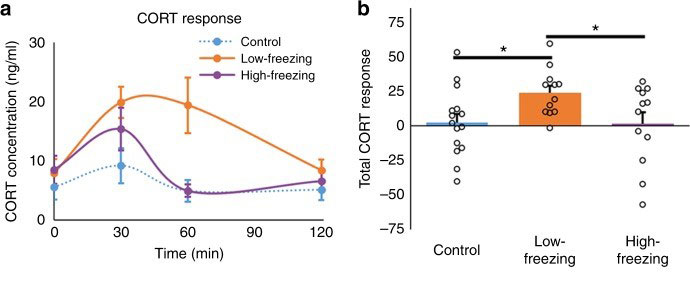The predator scent model is a rodent model of PTSD. Mice/rats are exposed to a compressed cotton pad cotton pad sprayed with predator urine such as fox or a clean pad in an inescapable cage for 10 minutes. Freezing duration and the location within the cage are recorded and analyzed using Ethovison software. Overall, animals exposed to predator odor display increased freezing and maintain greater distance from the cotton pad compared with control animals. However, the exposed animals can be further divided into two sub-populations whose freezing durations are higher compared with those of control animals (referred as “high freezing”), and animals whose freezing durations are similar to those of control animals (referred as “low freezing”). PTSD-like features such as elevated corticosterone level and decreased entry into and presence in the open arms of the elevated plus maze (EPM) are significantly more common among low freezing animals whereas the high freezing are more similar to control animals. This response profile contributes to the face validity of the predator scent model as only minority of those who are exposed to traumatic event develop PTSD symptoms.
Dofpel el al (2019) Nature Communications 10:2373 Figure 3
Time course of corticosterone (CORT) (in ng/ml) (a) and total CORT (b) for high-freezing, low-freezing, and control animals. Control animals showed no appreciable CORT change across time. High-freezing animals exhibited a relatively short CORT response, peaking at 30 min and returning to baseline at 60 min. The CORT response in low-freezing animals was prolonged, returning to baseline at 120 min. Low-freezing animals also showed a significant higher total CORT response than high-freezing (p = 0.031) and control (p = 0.017) animals.
References
Dopfel D, Perez PD, Verbitsky A, Bravo-Rivera H, Ma Y, Quirk GJ, and Zhang N. Individual variability in behavior and functional networks predicts vulnerability using an animal model of PTSD (2019). Nature Communications 10:2373
Ozbeyli D, Aykac A, Alaca N, Hazar-Yavuz AN, Ozkan N, and Sener G. Protective effects of vortioxetine in predator scent stress model of post-traumatic stress disorder in rats: Role of neuroplasticity and apoptosis (2019). Journal of Physiology and Pharmacology 70(4):557-571.

